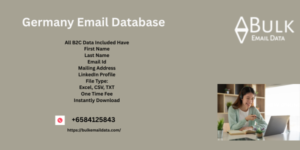To increase the number of orders, you need to not only attract new clients, but also work with the existing base. In addition to sending letters to Germany Email Database formed groups of subscribers, you can try a special tool - selecting a similar audience for mailing. We tell you how to collect this segment and which mailings are suitable for it.
What is a lookalike audience?
In marketing, a look-alike audience is a group of potential customers who are similar to people who have responded positively to advertising campaigns. The term is also abbreviated as LAL.
In email marketing, this is an audience that has not completed the desired target action, but has similar interests or needs with those who have already placed an order or viewed a certain product.

What data is needed to form a look-alike audience
This audience segment includes people with potential interest in a specific product or content.
Example. A subscriber visited a page with English lessons for the 6th grade. To understand what else he is interested in, you can look at the history of visits to other pages over the past six months. The segmentation results show that customers watched biology lessons for the same age group. And they found an interesting point - some Purchase Email Leads subscribers were interested in preparing for school. This means that this segment has two interests - biology and elementary school, but not for the older, but for the younger child.
The source of the database collection is the history of interaction with the site and email newsletters.
This segment of email recipients includes customers who have purchased a specific product. This way, you can understand which segment of a similar audience is more likely to make an order.
Example. The customer only bought hair growth shampoo and the company does not know what else to offer. You can collect a segment based on the latest orders and find out what else the customer paid for. The order history shows that he bought skin care cosmetics for mature skin. This means that the age audience of customers is 40 years and older and they are interested in skin care cosmetics for a certain age.
The source of the database collection is data from CRM or client profile.
An RFM analysis is conducted by the amount, recency and frequency of purchases. The segment includes customers with a certain percentage of completed orders or purchases in the selected category.
How to Improve Your Newsletter with RFM Analysis of Your Customers
How to Improve Your Newsletter with RFM Analysis of Your Customers
Example. Over the past 3 years, customers in segment #1 have bought 4 to 6 pairs of running shoes. These are loyal and regular buyers of sports shoes. To understand who in the base is actively involved in sports in the future, we look at what else subscribers from segment bought more than 4 times. The result is sports tapes. This means that the LAL segment should be collected by customers who bought sports tapes more than 4 times.